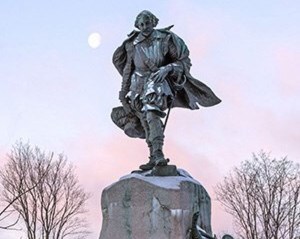OrilliaMatters received the following letter to the editor from Kate Grigg regarding our article and the recent letter to the editor about the future of Orillia's Champlain Monument.
********************
Here’s the thing: until you can change human nature – and that day is never going to come – human beings will squabble, and hurt themselves and each other, and foul up their lives and the world around them.
Messing with a statue isn’t going to change that.
The white man may want to ease his conscience for trampling on the native and the native may be angry with himself for being trampled but why should Vernon March’s magnificent work be the scapegoat?
The one enduring solace for the human condition is beauty. Mostly the natural kind: birds singing in the morning, the lake lapping at the shore, trees
reaching up to the sky, and occasionally, less often, manmade beauty.
The Champlain Monument (unlike certain items in the park) has earned its place there because it is of a calibre to match the beauty of its surroundings.
To reconfigure the monument or add an installation of some kind may well diminish it. One would, after all, be hard pressed to find someone of Vernon
March’s ability to produce such an installation.
The Champlain Monument should be put back with a larger plaque noting the native contribution and the white man’s sometimes overweening
ambition, explaining the collision of those two worlds.
And rather than an adjacent installation of ho-hum quality (a likely scenario considering recent acquisitions –– the third-rate bust of first-rate folk singer/songwriter Gordon Lightfoot, for instance, recently installed at the Opera House) a work of native art should also be erected.
And I mean the real thing. It’s not art just because someone native made it, or a woman instead of a man made it, or someone who wants to be an artist
made it, or someone who got a grant made it.
It’s art when it reaches a certain level of execution (the seen) combined with something uncanny, the unseen force of life, as the flesh and blood of the human eye somehow conveys the soul within.
A group of authentic, monumental totem poles would do the trick. There is something awesome about those imposing structures, a spirit that the carver
releases from the wood.
I don’t know if it is feasible to install and maintain authentic totem poles –– those, perhaps, from a similar era to the Champlain Monument, that actually once stood in native dwelling places –– but they would provide the perfect balance.
They and the Champlain Monument could stand together, speaking their individual and universal beauty.
I know many people don’t think of the park primarily as a place of beauty.
They don’t expect, as I do, that it should be, on its own scale, as beautiful and classy as New York’s Central Park.
I know many think of the park as a source of recreation, a place to take their bored children, or eat an ice cream cone, or zip around in a fast boat. And people do need entertainment and recreation. But whether they know it or not, they need more than that.
They need, if only for a moment, to stand before beauty. To stare up at a bronze statue or a fierce totem pole and transcend themselves and the everyday.
Kate Grigg
Orillia
********************



